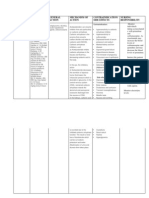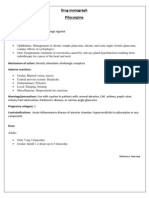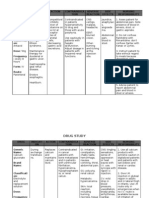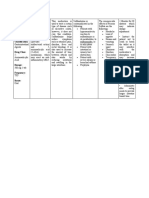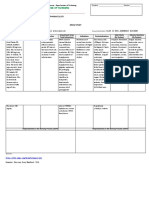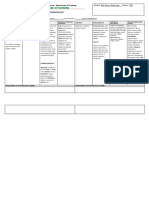Acetazolamide
Acetazolamide
Uploaded by
LIEZEL GRACE VELAYOCopyright:
Available Formats
Acetazolamide
Acetazolamide
Uploaded by
LIEZEL GRACE VELAYOOriginal Title
Copyright
Available Formats
Share this document
Did you find this document useful?
Is this content inappropriate?
Copyright:
Available Formats
Acetazolamide
Acetazolamide
Uploaded by
LIEZEL GRACE VELAYOCopyright:
Available Formats
Mindanao State University – Iligan Institute of Technology Student: _________________________ Section:___________
PHARMACOLOGY
DRUG STUDY
Brand Name: Diamox___________________________________ Generic Name: Acetazolamide ________________________ Drug Classification: Carbonic Anhydrase Inhibitor
Dosage, Route & Frequency Drug-Drug &
Side Effects Adverse Reactions
Drug Action Drug-Food Indications Contraindications
Recommended Prescribed (By System) (By System)
Interactions
Oral dosage (extended-release Inhibition of carbonic Drug-Drug: Lowering of intraocular Hypersensitivity or Dizziness, CNS: depression,
capsules) anhydrase in the eye results Excretion of pressure in the cross-sensitivity with lightheadedness, or fatigue, weakness,
Adults: 500 mg PO twice daily. The in decreased secretion of barbiturates, aspirin, treatment of glaucoma. sulfonamides may increased urination may drowsiness.
maximum dosage is 1 g/day. aqueous and lithium is Management of acute occur; Hepatic disease occur, especially during EENT: transient
Children and Adolescents 12 humor. Inhibition of renal increased and may altitude sickness. or insufficiency; the first few days as nearsightedness.
years and older: 500 mg PO twice carbonic anhydrase, resulting lead to decreased Unlabeled Use: Concurrent use with your body adjusts to the GI: anorexia, metallic
daily. Doses greater than 1,000 in self-limiting urinary effectiveness. Diuretic. Adjunct to the ophthalmic carbonic medication. Blurred taste, nausea, vomiting,
mg/day are not usually associated excretion of sodium, Excretion of treatment of refractory anhydrase inhibitors vision, dry mouth, melena. GU:
with an increased effect. potassium, bicarbonate, and amphetamine, seizures. Reduce (brinzolamide, drowsiness, loss of crystalluria, renal
Glaucoma water. CNS inhibition of quinidine, cerebrospinal fluid dorzolamide) is not appetite, nausea, calculi.
Adults: 250 mg PO every 4 hours. carbonic anhydrase and procainamide, and production in recommended; OB: vomiting, diarrhea, or Derm: STEVENS-
Alternately, treatment of some acute resultant diuresis may possibly tricyclic hydrocephalus. Avoid during first changes in taste may JOHNSON
types of glaucoma has been initiated decrease abnormal neuronal antidepressants is Prevention of renal trimester of pregnancy. also occur. SYNDROME, rashes.
with a dose of 500 mg, followed by firing. Alkaline diuresis decreased and may calculi composed of uric Endo: hyperglycemia
125 to 250 mg PO every 4 hours. prevents precipitation of uric lead to toxicity. May acid or cystine. F and E:
Intravenous dosage acid or cystine in the urinary increase hyperchloremic
Adults: 500 mg IV for acute lowering tract. cyclosporine levels. acidosis, hypokalemia,
of IOP or in patients unable to take Therapeutic Effects: growth retardation (in
the oral dosage. If needed, may Lowering of intraocular children receiving
repeat the dose in 2 to 4 hours. pressure. Control of some chronic therapy).
Acute Altitude Sickness types of seizures. Prevention Hemat: APLASTIC
Immediate release: 500-1000 and treatment of acute ANEMIA, HEMOLYTIC
mg/day PO divided q8-12hr altitude sickness. Diuresis ANEMIA,
Extended release: 500-1000 mg PO and subsequent mobilization LEUKOPENIA. Metab:
q12-24hr of excess fluid. Prevention of weight loss,
Congestive Heart Failure uric acid or cystine renal hyperuricemia. Neuro:
CHF-associated edema calculi. paresthesias.
250-375 mg (5 mg/kg) PO qAM Absorption: Dose Misc:allergic reactions
Seizure dependent; erratic with doses including
8-30 mg/kg/day PO qDay or divided 10 m g/kg/day. ANAPHYLAXIS.
q12hr Distribution: Crosses the
Drug-induced Edema placenta and blood-brain
250-375 mg PO/IV qDay barrier; enters breast milk.
Epilepsy Protein Binding: 95%.
Tablet: 8-30 mg/kg/day PO qDay, Metabolism and Excretion:
OR divided q6-12 hr; not to exceed Excreted mostly unchanged
30 mg/kg/day or 1 g/day in urine.
Half-life: 2.4– 5.8 hr.
Responsibilities in the Nursing Process (ADPIE) Responsibilities in the Nursing Process (ADPIE)
Assessment Patient/Family Teaching
● Observe for signs of hypokalemia (muscle weakness, malaise, fatigue, ECG changes, vomiting). ● Instruct patient to take as directed. Take missed doses as soon as possible unless almost time for next
● Assess for allergy to sulfonamides. dose. Do not double doses. Patients on anticonvulsant therapy may need to gradually withdraw
● Intraocular Pressure: Assess for eye discomfort or decrease in visual acuity.
medication.
● Seizures: Monitor neurologic status in patients receiving acetazolamide for seizures. Initiate seizure
precautions. ● Advise patient to report numbness or tingling of extremities, weakness, rash, sore throat, unusual
● Altitude Sickness: Monitor for decrease in severity of symptoms (headache, nausea, vomiting, fatigue, bleeding or bruising, fever, or signs/symptoms of a sulfonamide adverse reaction (Stevens-Johnson
dizziness, drowsiness, shortness of breath). Notify health care professional immediately if neurologic syndrome [flu-like symptoms, spreading red rash, or skin/mucous membrane blistering], toxic epidermal
symptoms worsen or if patient becomes more dyspneic and rales or crackles develop. necrolysis [widespread peeling/blistering of skin]) to health care professional. If hematopoietic reactions,
● Edema: Monitor intake and output ratios and daily weight during therapy fever, rash, hepatic, or renal problems occur, acetazolamide should be discontinued.
● May occasionally cause drowsiness. Caution patient to avoid driving and other activities that require
Potential Nursing Diagnoses
alertness until response to the drug is known.
Disturbed sensory perception (visual) (Indications)
● Caution patient to use sunscreen and wear protective clothing to prevent photosensitivity reactions.
Implementation ● Advise patient to notify health care professional of all Rx or OTC medications, vitamins, or herbal
● Do not confuse acetazolamide with acetohexamide. Do not confuse Diamox with Diabinese. products being taken and to consult with health care professional before taking other medications.
● Encourage fluids to 2000– 3000 mL/day, unless contraindicated, to prevent crystalluria and stone ● Intraocular Pressure: Advise patient of the need for periodic ophthalmologic exams; loss of vision may
formation. be gradual and painless.
● A potassium supplement without chloride should be administered concurrently with acetazolamide.
● PO: Give with food to minimize GI irritation. Tablets may be crushed and mixed with fruit-flavored syrup to Evaluation/Desired Outcomes
minimize bitter taste for patients with difficulty swallowing. Extended-release capsules may be opened and ● Decrease in intraocular pressure when used for glaucoma. If therapy is not effective or patient is unable
sprinkled on soft food, but do not crush, chew, or swallow contents dry. Extended-release capsules are only
to tolerate one carbonic anhydrase inhibitor, using another may be effective and more tolerable.
indicated for glaucoma and altitude sickness; do not use for epilepsy or diuresis.
● Decrease in the frequency of seizures.
● IM: Extremely painful; avoid if possible.
● Reduction of edema.
● Prevention of altitude sickness.
● Prevention of uric acid or cystine stones in the urinary tract
REFERENCES:
https://reference.medscape.com/drug/diamox-acetazolamide-342809
https://fadavispt.mhmedical.com/content.aspx?bookid=1873§ionid=139000247
https://www.webmd.com/drugs/2/drug-6753/diamox-oral/details
https://davisplus.fadavis.com/3976/meddeck/pdf/acetazolamide.pdf
You might also like
- 795B Master (v9)Document40 pages795B Master (v9)Rodrigo Bravo Rodrigo BravoNo ratings yet
- OfloxacinDocument2 pagesOfloxacinCarla Arciaga100% (1)
- Generic Name:: Drug Name Mechanism of Action Indications Contraindi-Cation Adverse Effects Nursing ResponsibilitiesDocument1 pageGeneric Name:: Drug Name Mechanism of Action Indications Contraindi-Cation Adverse Effects Nursing ResponsibilitiesmaemalabonNo ratings yet
- Process Industry Practices Coatings: PIP CTSL1000 Application of Internal LiningsDocument23 pagesProcess Industry Practices Coatings: PIP CTSL1000 Application of Internal LiningsSujita Sah100% (1)
- Generic Name: Contraindications: Before:: Diamox, Diamox SequelsDocument3 pagesGeneric Name: Contraindications: Before:: Diamox, Diamox SequelsRomwella May AlgoNo ratings yet
- Drug Name Mechanism of Action Administration Indications Contraindications Adverse Reactions Nursing ResponsibilitiesDocument1 pageDrug Name Mechanism of Action Administration Indications Contraindications Adverse Reactions Nursing ResponsibilitiesIvan Liquiran AvenadoNo ratings yet
- Drug Study Table 3Document5 pagesDrug Study Table 3Juliet De GuzmanNo ratings yet
- Drug Study ICUDocument5 pagesDrug Study ICUEcko MoawiaNo ratings yet
- DORMICUMDocument1 pageDORMICUMArian Rose100% (1)
- Mycophenolate MofetilDocument1 pageMycophenolate MofetilAndyPua100% (1)
- Amlodipine Drug StudyDocument2 pagesAmlodipine Drug Studymarengbib100% (9)
- ACETAZOLAMIDEDocument2 pagesACETAZOLAMIDEjhitch1683% (6)
- Drug Name Mecahnism of Action Indication Side Effects Generic NameDocument2 pagesDrug Name Mecahnism of Action Indication Side Effects Generic NamehahahaNo ratings yet
- CiticolineDocument1 pageCiticolineHarvey BanagNo ratings yet
- DRUG STUDY Magnesium SulfateDocument4 pagesDRUG STUDY Magnesium SulfateTempoNo ratings yet
- Metronidazole 500mg/tab 1 Tab 3xadayDocument4 pagesMetronidazole 500mg/tab 1 Tab 3xadayCrisyl LipawenNo ratings yet
- Drug Study Drug Name Mechanism of Action Dosage Indication Contraindication Side Effects Nursing InterventionsDocument5 pagesDrug Study Drug Name Mechanism of Action Dosage Indication Contraindication Side Effects Nursing InterventionsYvonne AgathaNo ratings yet
- DigoxinDocument4 pagesDigoxinJaessa FelicianoNo ratings yet
- Hydroxy ZineDocument2 pagesHydroxy ZineSharmaine Grace FlorigNo ratings yet
- Drug Study: AmoxicillinDocument3 pagesDrug Study: AmoxicillinKrzia TehNo ratings yet
- Drug StudyDocument2 pagesDrug StudyLee JennyNo ratings yet
- CALCITRIOLDocument2 pagesCALCITRIOLdesshe09No ratings yet
- Doxazosin MesylateDocument2 pagesDoxazosin Mesylateapi-3797941100% (1)
- Pilocarpine (Drug Monograph)Document1 pagePilocarpine (Drug Monograph)Muhammad ArsalanNo ratings yet
- Generic Name: Brand Name:: ClassificationsDocument2 pagesGeneric Name: Brand Name:: ClassificationsbillyktoubattsNo ratings yet
- Pedia Care Study - Appendix B - Drug StudyDocument8 pagesPedia Care Study - Appendix B - Drug Studyryan100% (1)
- AdenosineDocument2 pagesAdenosinegovind_soni_150% (1)
- Drug StudyDocument5 pagesDrug StudyGAYOL BREEN IRAH A.No ratings yet
- Erythromycin Drug StudyDocument2 pagesErythromycin Drug StudyJude LabajoNo ratings yet
- MetamucilDocument1 pageMetamucilSheri490No ratings yet
- Drug Study GentamicinDocument3 pagesDrug Study GentamicinEARL GERALD RICAFRANCANo ratings yet
- Drug Study Ciprofloxacin QuinosynDocument3 pagesDrug Study Ciprofloxacin QuinosynEmmanuel Margate100% (1)
- ApidraDocument4 pagesApidraRobert Ivan AgujarNo ratings yet
- Trimethoprim-Sulfamethoxazole-Bactim-DSDocument4 pagesTrimethoprim-Sulfamethoxazole-Bactim-DSAnika Pleños100% (1)
- Drug StudyDocument2 pagesDrug StudySunshine Jaranilla0% (1)
- ZonisamideDocument2 pagesZonisamideRo-anne AkuNo ratings yet
- Generic Name: Acute Aspirin ToxicityDocument1 pageGeneric Name: Acute Aspirin ToxicityShermayne Mallapre HernandezNo ratings yet
- OctreotideDocument3 pagesOctreotideHatim DziauddinNo ratings yet
- MethylprednisoloneDocument4 pagesMethylprednisoloneadryananestesiNo ratings yet
- NitrofurantoinDocument3 pagesNitrofurantoinapi-3797941No ratings yet
- Bacillus Clausii ErcefloraDocument1 pageBacillus Clausii ErcefloraCezhille BattadNo ratings yet
- Dextrose 50 InjectionDocument6 pagesDextrose 50 InjectionLip StickNo ratings yet
- Drug AnalysisDocument18 pagesDrug AnalysisArt Christian RamosNo ratings yet
- Drug StudyDocument3 pagesDrug StudyMarychen Cabunas100% (1)
- Calcium Gluconate Drug SummDocument1 pageCalcium Gluconate Drug SummAminah Yue100% (1)
- PentoxifyllineDocument2 pagesPentoxifyllineAshley Nordstrom CollinsNo ratings yet
- CetirizineDocument1 pageCetirizineGabby Robles Paje100% (1)
- Stugeron® TabletsDocument3 pagesStugeron® TabletsmahgadNo ratings yet
- Labetalol Hydro ChlorideDocument3 pagesLabetalol Hydro Chlorideapi-3797941100% (1)
- Drug StudyDocument2 pagesDrug StudyZeeham EscalonaNo ratings yet
- OxcarbazepineDocument4 pagesOxcarbazepineahmad_makhtarNo ratings yet
- As Pi LetDocument7 pagesAs Pi Letianecunar100% (1)
- Drug Study SulfasalazineDocument2 pagesDrug Study SulfasalazineBunnie AlphaNo ratings yet
- Medication Mechanism of Action Indication Contraindication Adverse Drug Reaction GenericDocument1 pageMedication Mechanism of Action Indication Contraindication Adverse Drug Reaction GenericTrisha CayabyabNo ratings yet
- Bicalutamide (Casodex) Drug StudyDocument2 pagesBicalutamide (Casodex) Drug StudyAtteya Mogote AbdullahNo ratings yet
- D5WDocument1 pageD5WBreena Reubee EstilloreNo ratings yet
- Drug Study (Aspirin, in Enalapril Maleate, Tramadol, AmlodipineDocument10 pagesDrug Study (Aspirin, in Enalapril Maleate, Tramadol, AmlodipineFlauros Ryu Jabien100% (1)
- Fluvastatin - Drug StudyDocument1 pageFluvastatin - Drug StudyKevin H. MilanesNo ratings yet
- Drug StudyDocument5 pagesDrug Studyjanelle123 toribioNo ratings yet
- HYOSCINEDocument1 pageHYOSCINEzyr2189No ratings yet
- Drug Study AmoxiclavDocument3 pagesDrug Study AmoxiclavIzza Deloria100% (1)
- AcetazolamideDocument3 pagesAcetazolamideGwyn RosalesNo ratings yet
- Diltiazem CardizemDocument2 pagesDiltiazem CardizemLIEZEL GRACE VELAYONo ratings yet
- 14Document1 page14LIEZEL GRACE VELAYONo ratings yet
- Sotalol HydrochlorideDocument2 pagesSotalol HydrochlorideLIEZEL GRACE VELAYONo ratings yet
- LisinoprilDocument3 pagesLisinoprilLIEZEL GRACE VELAYONo ratings yet
- Atenolol TenorminDocument3 pagesAtenolol TenorminLIEZEL GRACE VELAYONo ratings yet
- Chlorthalidone HygrotonDocument2 pagesChlorthalidone HygrotonLIEZEL GRACE VELAYONo ratings yet
- Furosemide ChlorthalidoneDocument5 pagesFurosemide ChlorthalidoneLIEZEL GRACE VELAYONo ratings yet
- ALISKIRENDocument2 pagesALISKIRENLIEZEL GRACE VELAYONo ratings yet
- Sotalol HydrochlorideDocument2 pagesSotalol HydrochlorideLIEZEL GRACE VELAYONo ratings yet
- Piperacillin TazobactamDocument2 pagesPiperacillin TazobactamLIEZEL GRACE VELAYONo ratings yet
- AmikinDocument2 pagesAmikinLIEZEL GRACE VELAYONo ratings yet
- LevofloxacinDocument3 pagesLevofloxacinLIEZEL GRACE VELAYO100% (1)
- CH 63 HSM IntroductionDocument8 pagesCH 63 HSM IntroductionRijane Tabonoc OmlangNo ratings yet
- Sedimentation in Zimbabwean Dam Projects: December 1998Document7 pagesSedimentation in Zimbabwean Dam Projects: December 1998Mercylin MakambureNo ratings yet
- Research Article Plasmodium FalciparumDocument5 pagesResearch Article Plasmodium FalciparumIsmail IkhsanNo ratings yet
- Have Been & Has Been & Had Been Example / ExercisesDocument3 pagesHave Been & Has Been & Had Been Example / ExercisesDecent ProductsNo ratings yet
- Consent Online SurveyDocument2 pagesConsent Online Surveyapi-239920772No ratings yet
- CE181 CE Law, Contracts & Ethics: Lecture - 6 Value EngineeringDocument26 pagesCE181 CE Law, Contracts & Ethics: Lecture - 6 Value EngineeringYves Harvey Garcia EscarezNo ratings yet
- Bivariate Analysis PDFDocument12 pagesBivariate Analysis PDFHygienix FsdNo ratings yet
- HR10 1PayrollProcessing04072018SignedDocument6 pagesHR10 1PayrollProcessing04072018SignedNithin akNo ratings yet
- CA Clarity PPM For Agile Development ProjectsDocument11 pagesCA Clarity PPM For Agile Development ProjectsDhaval ShahNo ratings yet
- Epicycloid Wikipedia 1675716594505Document12 pagesEpicycloid Wikipedia 1675716594505Jafar EarlNo ratings yet
- CHAPTER 1 The Teacher and The Community The School Culture and Organizational Leadership NewDocument34 pagesCHAPTER 1 The Teacher and The Community The School Culture and Organizational Leadership NewTres Marias100% (2)
- Backup Exec Interview QuestionDocument5 pagesBackup Exec Interview QuestionmailforasifNo ratings yet
- Model Predictive ControlDocument31 pagesModel Predictive ControleryancoNo ratings yet
- ICSE Class 10 Geography 2000Document14 pagesICSE Class 10 Geography 2000Adnan KhanNo ratings yet
- Supply Chain BasicsDocument1 pageSupply Chain BasicsDhanu ReddyNo ratings yet
- Satip A 004 03Document3 pagesSatip A 004 03Anonymous 4e7GNjzGW100% (1)
- Mass Media: A) Typy Masovo Komunikačných Prostriedkov (Printové A Elektronické Médiá, Ich Využitie, Výhody A Nevýhody)Document4 pagesMass Media: A) Typy Masovo Komunikačných Prostriedkov (Printové A Elektronické Médiá, Ich Využitie, Výhody A Nevýhody)Frede KmeťováNo ratings yet
- Book 3 - Road Safety at Work Site On Indonesian Roads MPWDocument98 pagesBook 3 - Road Safety at Work Site On Indonesian Roads MPWRahmadirgaNo ratings yet
- Marketing Activities Huyen Tran..Document2 pagesMarketing Activities Huyen Tran..Tuyền Nguyễn Thị ThúyNo ratings yet
- LogarithmsDocument59 pagesLogarithmsUnsa ManjudNo ratings yet
- SpringBoot Assignment - Pravardhan SajjanDocument9 pagesSpringBoot Assignment - Pravardhan Sajjansupriyameghavath2001No ratings yet
- Halba TribeDocument3 pagesHalba TribeAjay SonkusareNo ratings yet
- Useful Language Summary For Writing Task 2Document3 pagesUseful Language Summary For Writing Task 2ng jenny100% (1)
- Smc-Er3055 Manual PDFDocument32 pagesSmc-Er3055 Manual PDFNot ImportantNo ratings yet
- Cairn PDFDocument20 pagesCairn PDFlawdawgNo ratings yet
- Garmin G5000Document382 pagesGarmin G5000孙鹏No ratings yet
- Gr-500exl RH B GDocument2 pagesGr-500exl RH B GLaemarc Aler EstradaNo ratings yet
- Thyristor or Silicon Controlled Rectifier TutorialDocument7 pagesThyristor or Silicon Controlled Rectifier Tutorialmarcoms75No ratings yet











